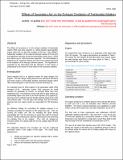Effects of Secondary Air on the Exhaust Oxidation of Particulate Matters
Author(s)
Pritchard, Joseph; Cheng, Wai K.
Download7_2015-01-0886 sec air on PMl.pdf (1.283Mb)
OPEN_ACCESS_POLICY
Open Access Policy
Creative Commons Attribution-Noncommercial-Share Alike
Terms of use
Metadata
Show full item recordAbstract
The effects of secondary air on the exhaust oxidation of particulate matters (PM) have been assessed in a direct-injection-spark-ignition engine under fuel rich fast idle condition (1200 rpm; 2 bar NIMEP). Substantial oxidation of the unburned feed gas species (CO and HC) and significant reduction of both the particulate number (up to ~80%) and volume (up to ~90%) have been observed. The PM oxidation is attributed to the reactions between the PM and the radicals generated in the oxidation of the feed gas unburned species. This hypothesis is supported by the observation that the reduction in PM volume is proportional to the amount of heat release in the secondary oxidation.
Date issued
2015-04Department
Massachusetts Institute of Technology. Department of Mechanical Engineering; Sloan Automotive LaboratoryJournal
SAE International Journal of Engines
Publisher
SAE International
Citation
Pritchard, Joseph, and Wai K. Cheng. “Effects of Secondary Air on the Exhaust Oxidation of Particulate Matters.” SAE Int. J. Engines 8, no. 3 (January 20, 2015).
Version: Author's final manuscript
ISSN
1946-3944
1946-3936